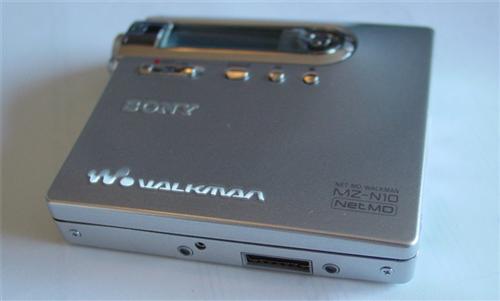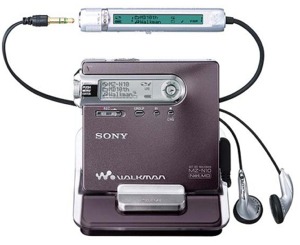|
N10 Review Index: Home In the box/Specs Design User Interface Remote Control General Operation NetMD/SonicStage 1.5 Final Thoughts |

[page 1] :: Next Page Sony MZ-N10 Review, December 2002
Introduction Over the last decade, the MiniDisc format has evolved from being marketed as a "replacement" to the CD format, to a viable replacement to the cassette format, and more recently to a competitor in the portable MP3 player market. The incredibly tiny and feather-weight MZ-N10 is Sony's offering in their 10th Anniversary line-up of MiniDisc units. While the N10 does not play MP3's directly (MiniDisc does not currently have a native ability to play mp3 files), the NetMD equipped MZ-N10 is Sony's best effort to combine the convenience of an MP3 player with the versatility, recording capabilities, and sound quality of the MD format. If you are not familiar with the MiniDisc format, I highly suggest taking a visit to www.minidisc.org. There is enough info there to answer most questions, and the forums there should provide answers for anything else you can't find.
What's new about the N10? Make no mistake - Sony has pulled out almost all of the stops to make this 10th anniversary model a special one - at least on the hardware side (the NetMD interface still leaves a lot to be desired). Most of the key improvements are in the way of added features and improvements in the user-interface.
What's NOT new in the N10? While Sony has put out a solidly polished product in the N10 with some significant feature additions, it doesn't offer any ground-breaking improvements in the way that the MZ-R900 introduced MDLP, or the way that the MZ-N1 introduced NetMD. While the speed of NetMD transfers may have been doubled, the N10 still requires a TOC EDIT (Table Of Contents EDIT) after each track is downloaded, which adds anywhere from 8 - 15 seconds per song. So while a 4 minute song recorded in LP2 may transfer in less than 8 seconds, the entire transfer/write operation will still take about 16 seconds. So if you are transferring 20 songs, 4 minutes each (totaling 80 minutes of music), the actual transfers will only take about 150 seconds (2 and 1/2 minutes), but the TOC EDITS will take roughly an additional 2-3 minutes themselves. Sony may have done better to redesign the NetMD engine to just do one TOC EDIT after all the songs in a transfer operation are written to disc, as is done with realtime recording. NetMD uploads are still nowhere to be found, and the clunky "check-in/check-out" interface of the OpenMG/SonicStage software makes transferring MP3's to your minidiscs more of a hassle than it should be (essentially for any MP3 to be transferred to MD, a 2nd copy of it must be created in ATRAC3 format; thus importing your entire music library to OpenMG Jukebox/SonicStage would effectively double your hard-disk usage.) And it is still not possible to do true SP (292kbps ATRAC) transfers via the NetMD interface. The LCD on the main unit is still lacking a backlight, and the readability of the main LCD has slightly worsened due to the poor contrast (which can't really be rectified by adjusting the contrast level in the options menu). Import Notes As of the writing of this review (November 2002), the MZ-N10 is only available from Japan; a domestic release in the US or Europe has not yet been announced, but don't expect it before Spring 2003. Typically Japanese Sony MD units have always been fairly "import-friendly", with instruction manuals containing extensive English sections, and even English OpenMG Jukebox software which was included with the Japanese model of the MZ-N1. This seems to have changed for this particular model, as the N10's instruction manual does not have an English section, nor does the included software CD come with an English option (unless you have Japanese support on your version of Windows, the menus in the software will show up as complete gibberish). However if you can track down an English version of OpenMG Jukebox, you can choose to install just the N10 drivers (the 2nd option from the included CD-ROM's installation start-up screen), and you will have all of the desired functionality (including the faster download speeds). This method will be much preferred if you cannot read Japanese, and if you don't have Japanese language support installed on your system. More about this on Page 7 of this review...
[page 1] :: Next Page
|

